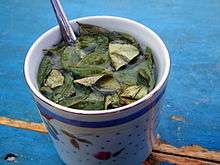Coca tea


Coca tea, also called mate de coca, is an herbal tea (infusion) made using the (typically raw) leaves of the coca plant, which is native to South America. It is made either by submerging the coca leaf or dipping a tea bag in hot water. The tea is most commonly consumed in the Andes mountain range, particularly Argentina, Bolivia, Colombia and Peru. It is greenish yellow in color and has a mild bitter flavor similar to green tea with a more organic sweetness.
Though also known as mate, mate de coca has very little in common with the yerba mate drink in Southeastern South America.
Alkaloid content and stimulant properties
The leaves of the coca plant contain alkaloids which—when extracted chemically—are the source for cocaine base. However, the amount of coca alkaloid in the raw leaves is small. A cup of coca tea prepared from one gram of coca leaves (the typical contents of a tea bag) contains approximately 4.2 mg of organic coca alkaloid.[1] (In comparison, a line of cocaine contains between 20 and 30 milligrams.[2]) Owing to the presence of these alkaloids, coca tea is a mild stimulant; its consumption may be compared to consumption of coffee or tea.[3] The coca alkaloid content of coca tea is such that the consumption of one cup of coca tea can cause a positive result on a drug test for cocaine, however.[1]

Similar to decaffeination in coffee, coca tea can be decocainized.[4] Just as decaffeinated coffee retains a minute quantity of caffeine, decocainized coca tea will still contain a minute quantity of organic coca alkaloids.[4]
Legal status
Coca tea is legal in Colombia, Peru, Bolivia, Argentina, Ecuador,[5][6] and Chile. However, its use is being discouraged in part by the Single Convention on Narcotic Drugs. Coca tea is illegal in the United States unless it is decocainized.[4]
Medicinal and traditional uses
Many Andean indigenous peoples use the tea for medicinal purposes.[7]
Coca tea is often recommended for travelers in the Andes to prevent altitude sickness.[8] However, its actual effectiveness has never been systematically studied.[8]
Coca tea has been used to wean cocaine addicts off the drug.[9]
See also
| Wikimedia Commons has media related to Mate de coca. |
- Coca-Cola, an international soft drink made with decocainized coca leaf
- Coca Colla, a similar Bolivian drink but which still contains cocaine
- Cocoroco, a very strong Bolivian alcoholic beverage
References
- 1 2 Jenkins AJ, Llosa T, Montoya I, Cone EJ (1996). "Identification and quantitation of alkaloids in coca tea.". Forensic Sci Int. 77 (3): 179–89. doi:10.1016/0379-0738(95)01860-3. PMC 2705900
 . PMID 8819993. >
. PMID 8819993. > - ↑ Jerome J. Platt (2000). Cocaine Addiction: Theory, Research and Treatment. Harvard University Press. p. 28. ISBN 978-0-674-00178-7.
- ↑ Jim Shultz; Melissa Draper (2008). Dignity and Defiance: Stories from Bolivia's Challenge to Globalization. University of California Press. p. 183. ISBN 978-0-520-25699-6.
- 1 2 3 Amitava Dasgupta (2010). Beating Drug Tests and Defending Positive Results: A Toxicologist's Perspective. Springer. p. 106. ISBN 978-1-60761-526-2.
- ↑ Matthew Garrahan (June 18, 2010). "When Hugo met Oliver". Financial Times Magazine.
- ↑ Richard K. Ries; Shannon C. Miller; David A. Fiellin (2009). Principles of Addiction Medicine. Lippincott Williams & Wilkins. p. 165. ISBN 978-0-7817-7477-2.
- ↑ Substances that produce addiction Archived October 26, 2006, at the Wayback Machine. – University of Buenos Aires (Spanish).
- 1 2 Andrew M. Luks, et al. "Wilderness Medical Society Consensus Guidelines for the Prevention and Treatment of Acute Altitude Illness". Wilderness & Environmental Medicine, 21, 146–155 (2010).
- ↑ Ronald K. Siegel (2005). Intoxication: The Universal Drive For Mind-Altering Substances. Inner Traditions * Bear & Company. p. 297. ISBN 978-1-59477-069-2.